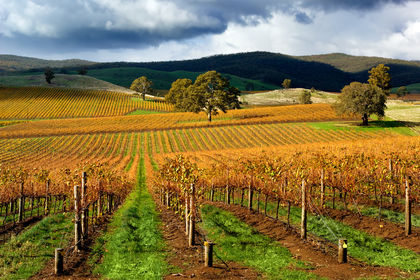Australia - Agriculture

Australia is an important producer and exporter of agricultural products and a major world supplier of cereals, sugar, and fruit. Arable land in 1998 comprised about 53.1 million ha (131.2 million acres), representing about 6.9% of total land area. However, approximately 90% of the utilized land area is in its natural state or capable of only limited improvement and is used largely for rough grazing. Droughts, fires, and floods are common hazards. The area actively cultivated for crops is 6.9% of all land area. Lack of water is the principal limiting factor, but unsuitable soil and topography are also important determinants. As of 1998, some 2,700,000 ha (6,672,000 acres) of land were irrigated. Agriculture has declined from 20% of GDP in the 1950s to about 3% in 2001. Agricultural exports, which accounted for 60% of Australia's exports in the 1960s, now account for 25%. Gross farm product in 1999/2000 was A $28.5 billion. New South Wales and Queensland account for half of the total crop value.
Grain crops have been cultivated since the first year of European settlement. In November 1790, plantings around Sydney of wheat, barley, and corn totaled 34 ha (84 acres). Today, winter cereals are cultivated in all states. Three cereals are often grown on one farm for grain, green fodder, and hay for livestock. Most wheat, barley and about half the oats are grown for grain. The estimated wheat area sown for grain increased from 11,135,000 ha (27,515,000 acres) in 1986/87 to 12,200,000 ha (30,150,000 acres) in 1999/2000. Production of wheat in 1999/2000 was an estimated 24.8 million tons. Western Australia and New South Wales are the chief wheat-producing states. In 1999, Australia produced 4,360,000 tons of barley, 1,503,000 tons of oats, and 1,410,000 tons of rice. In 1999/2000, 1.2 million tons of potatoes were produced.
Sugarcane is grown along a 2,000 km (1,200 mi) stretch of coastal land in New South Wales and Queensland. About 95% of sugar production comes from Queensland. A normal crushing season is from June to December. The estimated 1999 harvest from 415,000 ha (1,025,000 acres), yielded about 36.9 million tons of sugar cane. The industry faces problems of excessive supply and price elasticity; sugar is sold primarily to Japan, the United States, Canada, South Korea, Malaysia, China, and Singapore. Although tobacco growing is a relatively small industry, it is important in some areas. In 1999, some 3,000 ha (7,400 acres) were planted with tobacco, and about 7,000 tons were produced.
Cotton has been grown in the coastal river valleys of Queensland for more than a century but on a limited scale, and it has provided only a small percentage of Australia's lint requirements. In the 1980s, however, successful development of cotton-growing areas in New South Wales and Western Australia has resulted in spectacular production increases. In 1985/86, 685,000 tons of cotton were produced (almost triple the amount in 1979/80); in 1999, production amounted to 716,000 tons.
Australia's wide climate differences permit the cultivation of a range of fruits, from pineapples in the tropical zone to berry fruits in the cooler areas of temperate zones. Orchard fruit trees included orange, 7.8 million; apple, 9.7 million; pear, 1.5 million; and peach, one million. About 12.2 million ha (30.1 million acres) are cultivated for bananas and 4.8 million ha (11.9 million acres) for pineapples. Production of fruit in 1999 included (in thousands of tons): oranges, 470; bananas, 230; pineapples, 123; pears, 165; peaches, 90; tangerines, 61; lemons and limes, 31; apricots, 20; grapefruit, 18; mangoes, 37; and plums, 27. Australia's wine industry is also growing; viticulture engaged 99,000 ha (245,000 acres) and produced 1,112,000 tons of grapes for winemaking, drying, and other uses in 1999.